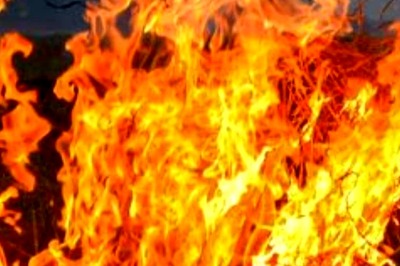
views
The dust generated from the demolition of the Supertech twin towers in Noida on Sunday did not make its way across the border to Delhi, all thanks to favourable wind direction. Experts said the north and northwesterly winds blew the dust towards Greater Noida and further into Uttar Pradesh instead of towards the national capital, according to an article published by Hindustan Times.
The high-intensity blasts that brought down the 100-metre tall buildings generated a dust storm, which was expected to affect the air quality of the surrounding areas. But, air quality monitoring stations in Delhi, located closest to the demolition site, did not indicate an increase in the PM10 concentration.
Stations of the Delhi Pollution Control Committee (DPCC) at Okhla Phase 2, Dr Karni Singh Shooting Range and Patparganj, located close to the Delhi-Noida border, failed to show a spike in PM10 around 3 pm after the demolition took place.
The Met has forecast that wind direction is going to remain unchanged, which means it will stay northwesterly, for the next 24 hours. PM10 levels, as opposed to PM2.5, are an indication of dust that comprises coarser particles. Dust storms increase the PM10 concentration in the air, and they have been a common factor affecting Delhi’s air quality over the past few years. Higher PM10 concentration has made the national capital’s air quality ‘very poor’ or ‘severe’ in even summer months.
The demolition also did not quite affect the air quality in Noida itself, with experts saying it was “within acceptable limits”. The Noida Authority was constantly monitoring the air quality after the demolition while agencies present at the site used anti-smog guns to battle the dust generated from the blasts. According to reports, the dust has settled in the area and safety parameters have been reduced to barely a few feet from the rubble. Media, however, got closer access to the debris.
According to the HT article, the reading at the Patparganj station, which is the nearest continuous ambient air quality monitoring station (CAAQMS) in east Delhi, only showed a minimal increase after the demolition. The hourly PM10 concentration increased from 130 micrograms per cubic metre at 2 pm to a reading of 149 micrograms per cubic metre at 3pm before dropping back down to 132 micrograms per cubic metre at 4pm.
At the Okhla Phase 2 CAAQMS in south Delhi, relatively close to Delhi-Noida border, showed a decrease in PM10 from 2 pm showing there was no impact of the controlled blasts on air quality.
“Wind direction is north to northwesterly and following the explosion, the dust began to gradually blow towards Greater Noida. Wind direction is likely to stay northwesterly till at least Monday afternoon and after that, it may switch to easterly. Even then, Delhi is unlikely to be impacted by this dust,” Mahesh Palawat, vice president at Skymet meteorology, was quoted as saying by HT.
The IMD has also predicted light rain in parts of Delhi on Monday, while saying the wind direction is likely to stay northwesterly for majority of the next three days. A Met official said rain will cause any remnants of the dust to settle and there will not be much impact of this event.
On Sunday, Delhi’s air quality index was recorded to be ‘moderate’ with a reading over a 24-hour period at 119, as per data released at 4 pm by the Central Pollution Control Board. This was slightly higher than the AQI on Saturday, which was recorded within the same time period.
“The air quality over Delhi is likely to remain in the ‘moderate category’ on Sunday and Monday. The air quality is then likely to improve but remain in the ‘moderate’ to ‘satisfactory’ category on Tuesday and will improve to the ‘satisfactory’ category on Wednesday,” the forecast issued by the MoES-developed system states.
An AQI between 0 and 50 is considered ‘good’, 51 and 100 ‘satisfactory’, 101 and 200 ‘moderate’, 201 and 300 ‘poor’, 301 and 400 ‘very poor’, and 401 and 500 ‘severe’.
Noida Authority CEO Ritu Maheshwari said the AQI & PM10 levels before and after the demolition were closely monitored by 20 monitoring stations with the help of Intelligent Traffic Management System. According to the latest bulletin by Noida authority at 4 pm, the AQI was 56.6 with PM10 at 78, both ‘satisfactory’ in Sector 91, while Sector 116 reported ‘moderate’ air quality at 126 AQI and PM10.
Trees and plants in the vicinity were covered in sand, dust and powdered concrete. They were being hosed by tankers, up and down the road in front of the site. Across the road from the site is a large park where even the grass on the ground was covered by a thick layer of dust.
Air in the area was filled by the smell of wet concrete and onlookers complained of what felt like soot on their skin. Many people gathered at the site after the demolition, including residents of a nearby village. They were not wearing masks though some older people and children were seen with their mouths covered.
Health experts had previously warned of eye irritation, dust allergy, bouts of unstoppable coughing and other symptoms for residents positioned nearby, especially those with already existing health issues.
Read all the Latest News India and Breaking News here



















Comments
0 comment